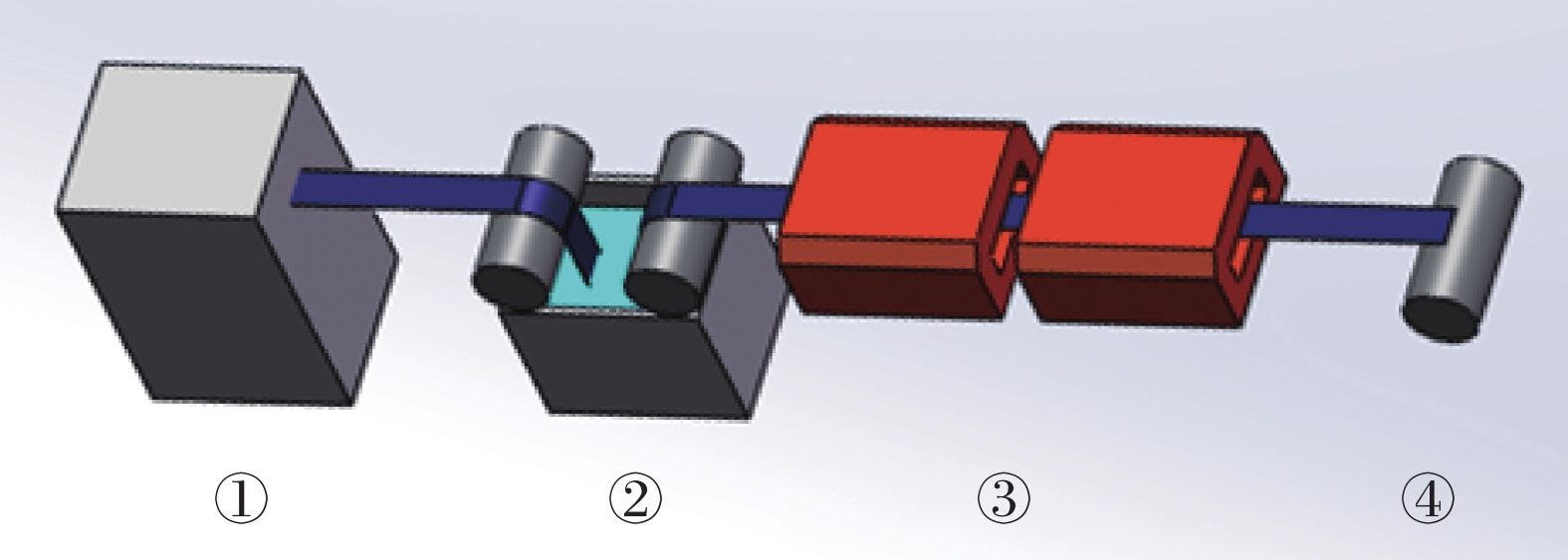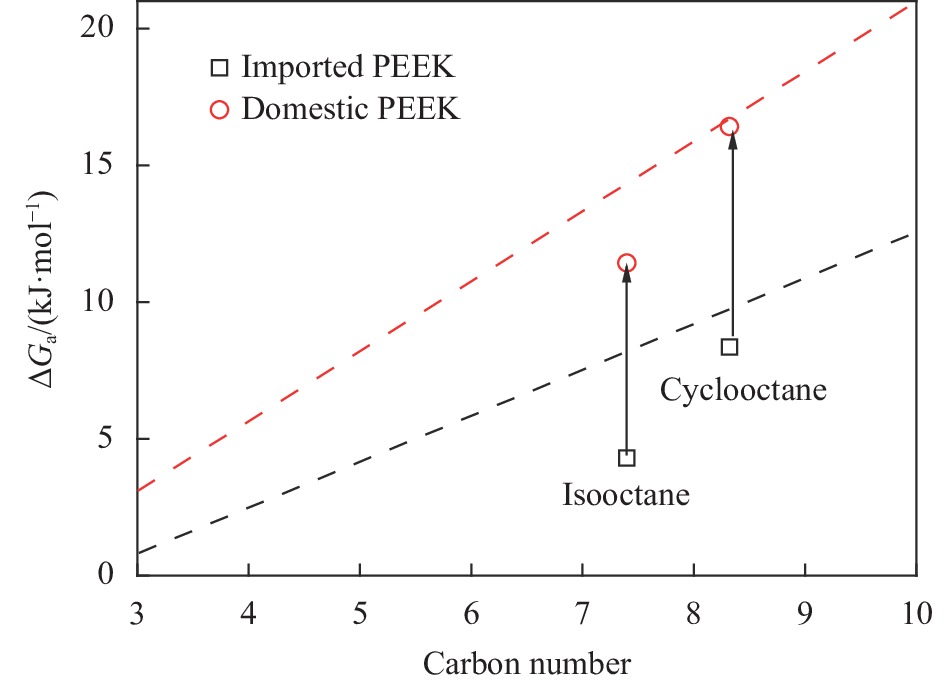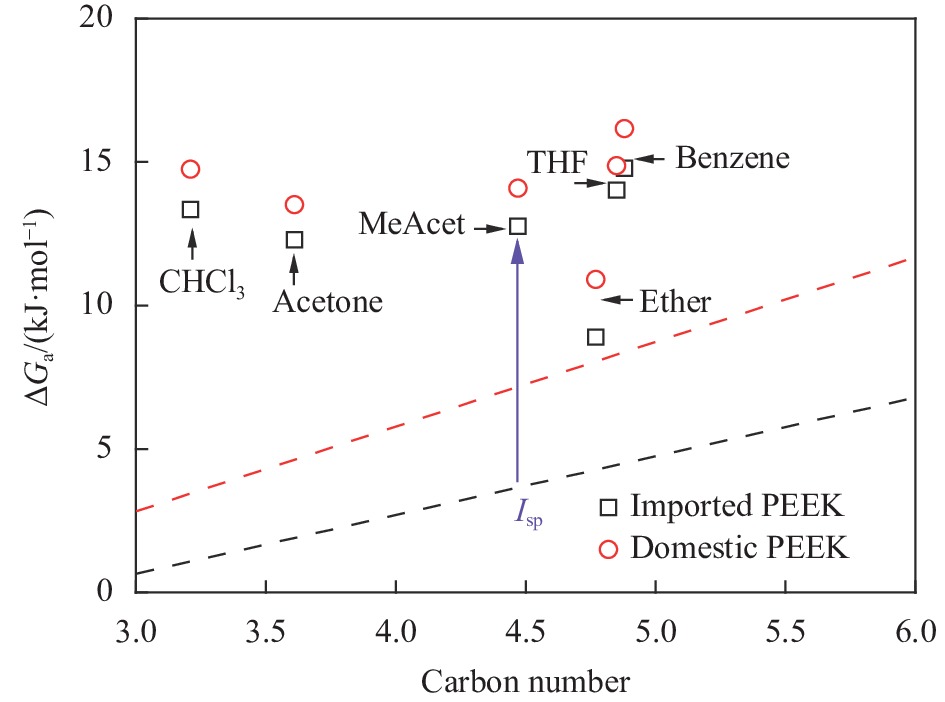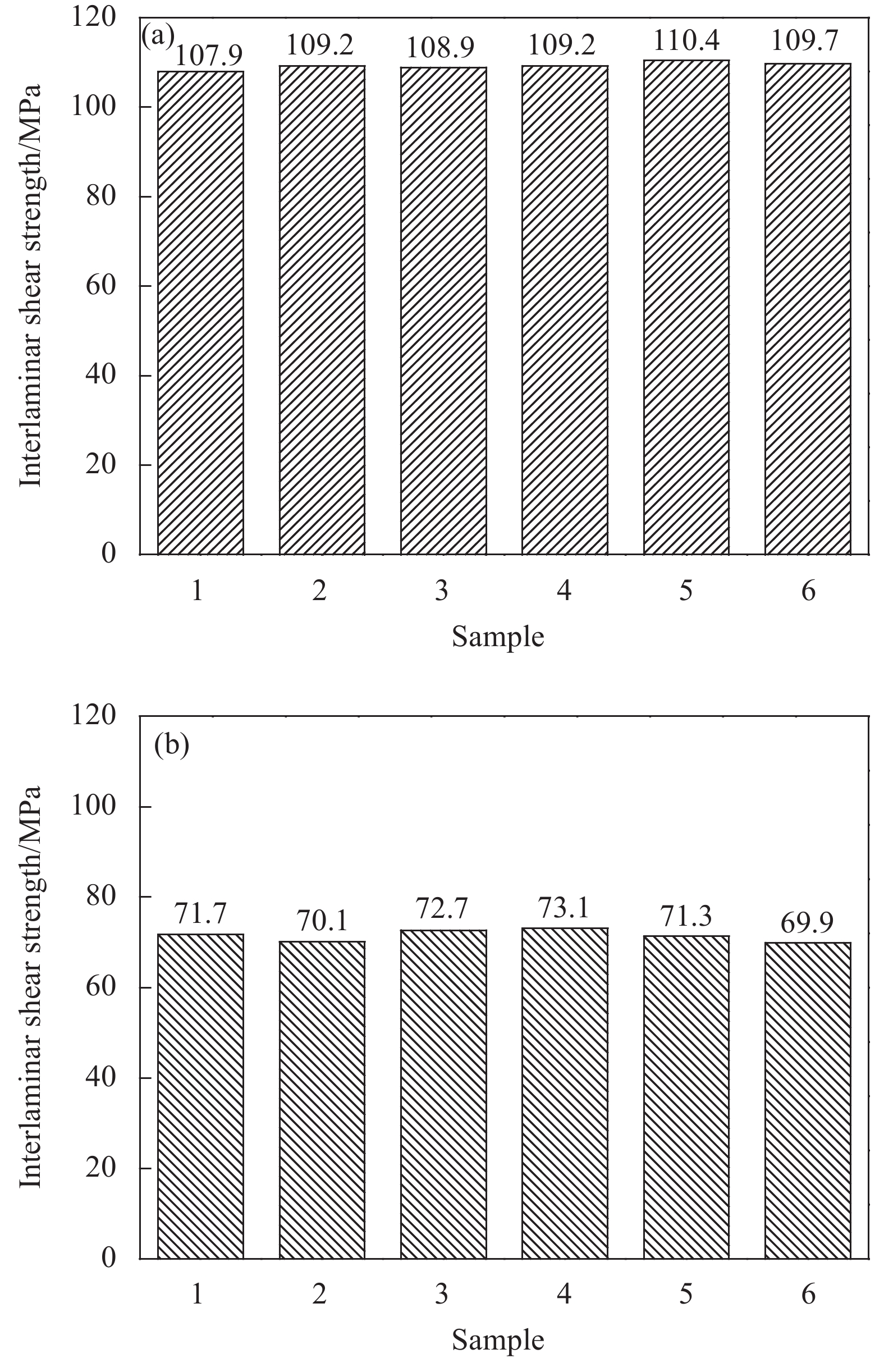Surface characterization of polyether-ether-ketone by inverse gas chromatography and the application in the improvement of thermoplastic composites interlaminar performance
-
摘要: 高性能热塑性聚醚醚酮树脂基复合材料具有高韧性、耐疲劳、原材料可长期贮存、成型速度快、可重复加工和回收再利用等独特优势,在航空航天等工业领域应用广泛。粉末悬浮法通过将聚醚醚酮细粉配制成水基悬浮液实现对纤维充分浸渍,现已成为制备连续纤维增强热塑性预浸料的重要方式。本文重点开展反气相色谱法研究聚醚醚酮表面性质,并结合微观形貌、粒径分布等方面对比国内外聚醚醚酮树脂的差异。研究表明:进口聚醚醚酮树脂色散表面能(19.2 mJ/m2)明显低于同级别国产树脂(41.1 mJ/m2);极性探针分子吸附于聚醚醚酮表面的驱动力主要是酸碱作用力,表面总体表现为碱性。进口聚醚醚酮树脂相比于国产具有更高的极性,使其更容易分散在水中;而国产聚醚醚酮树脂微观形貌、表面性质则更加均匀。表面性质研究指导水基悬浮液配制,制备的连续纤维增强热塑性预浸料质量优异,孔隙率低于0.5%且纤维排布整齐,热塑性复合材料层压板层间剪切强度平均值达109 MPa,与传统热熔浸渍方法相比提升30%以上。Abstract: High performance polyether-ether-ketone (PEEK) thermoplastic composites have the advantages of good impact and fatigue resistance, unlimited ambient temperature storage life, short molding cycles, being recyclable and good reprocessing ability, which have been widely used in aerospace and other industry domains. Powder impregnation method can realize the infiltration of resin particles into fibers by water-based suspension, which has become an effective technical route for preparing continuous fiber reinforced thermoplastic prepregs. This paper focused on the surface characterization of PEEK produced in both domestic and overseas by inverse gas chromatography (IGC) as well as the comparison of microstructure and size distribution. The results show that the dispersion surface energy value of imported PEEK (19.2 mJ/m2) is obviously lower than the domestics (41.1 mJ/m2). The driving force of the adsorption between PEEK particles and polar probe molecules is acid-base interaction in nature, while the surface of PEEK particles is generally alkaline. With higher surface polarity, imported PEEK can more easily disperse into water through the dispersant. By preparing the water-based resin slurry based on the surface characterization results, the thermoplastic prepregs produced with powder impregnation method show excellent quality. The porosity of the powder impregnation prepregs is less than 0.5% and fibers are neatly arranged, with the short beam shear strength of 109 MPa, 30% higher comparing with prepregs produced by traditional hot melt impregnation method.
-
碳纤维增强聚合物复合材料(CFRP)具有高强、质轻、抗疲劳性能好和施工方便等优点,目前不仅被广泛应用于钢筋混凝土结构的加固中,同时也用在砌体结构的加固中[1-6]。CFRP加固砌体结构是通过CFRP与砌体材料界面间的粘结力,使两种材料组合在一起协同工作并传递荷载。因此,CFRP与砌体材料之间良好的粘结性能是保证CFRP与砌体结构共同受力变形的基础[7-8]。关于CFRP加固砌体结构,国内外学者做了大量研究,而关于CFRP-砌体界面性能只有少部分学者进行了研究并提出不同的界面粘结-滑移模型,这些模型基本上能准确模拟粘结界面的受力情况[9],但对于冻融环境下界面粘结-滑移模型未见公开报道。在冻融环境中,粘土砖的性能会随着时间的推移有所退化,在一定程度上会影响界面粘结性能,最终引起不可避免的耐久性问题[10-12]。因此,对冻融循环作用下CFRP与粘土砖之间粘结性能进行相应研究具有十分重要的意义。
通过简单可靠的单剪试验探究了冻融循环作用下CFRP-粘土砖界面在外力作用的破坏过程及破坏形态,得到了界面剥离承载力在循环作用下的变化规律,通过试验测得的应变得到了冻融循环过程中剪应力的发展及分布规律,并给出了考虑冻融循环影响的界面粘结-滑移关系。
1. 实验材料及方法
1.1 试件设计及制作
试验所使用碳纤维增强聚合物复合材料(CFRP)和树脂均为上海滠口实业有限公司生产,其主要性能如表1所示。试验所使用粘土砖的抗压强度平均值为9.28 MPa,吸水率约为17.58%,平均密度约为1 700 kg/m3。试验所用胶粘剂为SKO-碳纤维浸渍胶,其主要性能如表2所示。
表 1 碳纤维增强聚合物复合材料(CFRP)的性能Table 1. Properties of carbon fiber reinforced polymer(CFRP)Sample Tensile
strength/MPaModulus/
GPaElongation/
%Thickness/
mmCFRP ≥3 500 220 1.458 0.111 表 2 粘结树脂的性能Table 2. Properties of impregnation resinTensile shear strength/MPa Tensile strength/GPa Compressive strength/MPa Bending strength/MPa Positive tensile bond strength/MPa Modulus/MPa Elongation/% 24.29 40.12 73.62 72.95 4.44 2 605.7 2.45 本试验选用的粘土砖尺寸为235 mm×115 mm×55 mm,CFRP片材粘贴在粘土砖的一个表面(如图1所示),CFRP粘贴尺寸设计为6种规格,试件的具体参数如表3所示。
表 3 CFRP-粘土砖单剪试验试件参数Table 3. Specimen parameters of CFRP-clay brick specimens for single shear testCFRP size(Length×width)/mm Number of CFRP-clay brick specimen 0 cycle 20 cycles 40 cycles 60 cycles 80 cycles 80×50 5 5 5 5 5 100×80 5 5 5 5 5 80×80 5 5 5 5 5 100×80 5 5 5 5 5 80×100 5 5 5 5 5 100×100 5 5 5 5 5 参照CECS 146—2003[13]中相关要求将CFRP粘贴在粘土砖表面。为防止粘土砖出现局部拉剪破坏,粘结CFRP时在加载端留出30 mm非粘结区,制作完成的试件如图1所示,标准试件示意图如图2所示。
1.2 实验装置及加载程序
冻融循环试验参照GB/T 2542—2012[14]进行。将试件清理干净,在鼓风干燥箱内烘干达到质量要求后,将其在20℃的水中浸泡24 h后取出拭干水分,在冷冻箱内温度降至−15℃时开始计时。每次冷冻时间为3 h,融化2 h,控制冷冻温度为(−17±2)℃,融化水的温度控制在(15±2)℃。冻融循环次数分别取0次、20次、40次、60次和80次。
所有试件的单剪试验均在济南恒思盛大仪器有限公司生产的WDW-50微机控制电子万能试验机上通过自制单剪试验盒进行(如图3(a)所示),通过电脑控制加载速度,由荷载传感器输出CFRP与粘土砖的粘结荷载,CFRP的应变值通过江苏东华DH3816静态应变测试系统采集(如图3(b)所示)。为了使CFRP片材在加载过程中受力均匀,在试件加载端片材上下各粘贴一层30 mm长的CFRP加强片,加强片与试件同宽。加载过程采用位移控制,加载速率为0.5 mm/min。在CFRP试件拉伸前,先施加约为破坏荷载5%的预拉荷载(约为0.4 kN),检查夹具、拉力机和应变采集系统运行是否正常。
2. 试验现象
2.1 冻融循环对CFRP-烧结粘土砖界面的作用效果
试验发现,在经过若干次冻融循环后,CFRP-烧结粘土试件界面发生了较为明显的变化,以粘贴长度×宽度为80 mm×50 mm的单剪试件为例,图4为不同冻融循环作用下CFRP-烧结粘土砖界面破坏情况。可知,室温下试件破坏发生后,CFRP片材上粘有大颗粒粘土砖碎屑(如图4(a)所示);冻融20次和40次的试件破坏后,CFRP片材上粘有的粘土砖颗粒较小(如图4(b)所示);冻融60次后,其中2个试件破坏面较40次严重,界面上粘有大量粘土砖颗粒(如图4(c)所示),另1个试件与冻融40次的形态基本相同;冻融80次后,试件破坏发生在粘土砖,界面发生剪切破坏(如图4(d)所示),说明冻融循环作用对界面粘结性能有不利影响。
表4为粘贴长度×宽度为80 mm×50 mm的CFRP-粘土砖单剪试件试验结果。可以看出,随着冻融次数的增加,界面承载力逐渐降低,60次冻融后减小了约12%,表明冻融循环作用对CFRP-粘土砖的界面承载力有着不利影响。因此,当使用CFRP对粘土砖结构进行加固时,如果是在北方寒冷地区应适当考虑界面粘结折减系数。
表 4 CFRP-粘土砖界面承载力平均值和降低幅度Table 4. Average interfacial bearing capacity and reduction of CFRP-brick specimensCFRP size(Length×width)/mm Interfacial baring capacity/kN Decrease of bearing capacity/% 0 cycle 20 cycles 40 cycles 60 cycles 80 cycles 0 cycle 20 cycles 40 cycles 60 cycles 80 cycles 80×50 7.63 7.52 6.85 5.93 5.34 — 1.44 10.22 22.28 30.01 100×50 7.95 7.88 7.07 6.95 6.43 — 0.88 11.07 12.58 19.12 120×50 8.12 8.15 7.26 7.06 6.65 — –0.37 10.59 13.05 18.10 80×80 12.40 12.00 11.40 11.00 10.30 — 3.23 8.06 11.29 16.94 100×80 13.00 12.80 12.30 11.60 10.50 — 1.54 5.38 10.77 19.23 120×80 13.50 13.20 12.50 11.70 11.00 — 2.22 7.41 13.33 18.52 从试验及文献分析可知,造成界面承载力降低的原因主要有两点:(1)冻融作用导致粘土砖自身材料强度降低而引起CFRP-粘土砖试件粘结强度降低;(2) CFRP-粘土砖之间的胶体面层的粘结性能退化。由于CFRP的特殊构造,其聚合物基体的孔径较小,冻融循环作用下,其孔隙中的水不会冻结[15]。因此,可能是胶体吸水后,在冻融作用下,当溶胀和温度应力共同作用时,界面产生微裂纹,从而导致介质水在界面上冻结产生应力。
2.2 CFRP-粘土砖单剪试验破坏形态
由于本次试验在CFRP-粘土砖试件加载端预留了30 mm非粘结区,所有CFRP-粘土砖试件均是CFRP与粘土砖之间发生界面剥离而破坏的,没有发生CFRP布的撕裂破坏,也没有发生粘土砖的拉剪破坏。
所有CFRP-粘土砖试件剥离破坏是由纤维布传递荷载到粘土砖,从而使粘土砖内部产生的微小裂缝逐渐发展导致的。对于没有经过冻融循环的CFRP-粘土砖试件,其破坏过程是初始加载时除了碳纤维布开始绷紧外,试件并无明显变化,加载端的应变基本呈线性增加;当荷载增加至剥离荷载的40%左右时,可以听到“噼啪声”,加载端附近的应变迅速增加,粘土砖内部微裂缝逐渐开展,试件开始发生局部粘结破坏,总的粘结面积开始减少;随着荷载的进一步增大,应变急速增加,剥离深度也在加大,距离加载端较远处应变片的应变也逐渐增大,说明剥离逐渐向自由端发展。当剩余的粘结面积不足以抵抗荷载时,破坏瞬间发生。而在冻融循环作用下,破坏具有相似性,只是由于粘土砖与胶层之间的界面被削弱、粘土砖材料本身强度降低,开裂速度较未经循环试件更迅速,破坏更突然。
3. 结果与分析
3.1 冻融循环作用下粘土砖孔隙结构损伤
粘土砖为多孔材料,在水冻作用下,粘土砖内部孔隙中的水分子会出现冻结现象,造成孔隙体积膨胀,从而使粘土砖内部出现较大的微孔隙损伤和拉应力,使砖体的缝隙和节理出现加深和扩大;当粘土砖处于融化状态时,粘土砖内部微孔隙会出现迁移现象。当粘土砖在不同温度下进行反复冻结和溶解时,张力使孔隙壁的损伤不断加剧,最终造成砖体损伤。这种损伤反映到CFRP-粘土砖的粘结上,便会出现粘结退化现象。
图5为不同冻融循环作用下粘土砖孔隙度变化。图6为不同冻融循环作用下粘土砖弛豫时间T2谱分布。从图5可以看出,随着冻融循环次数的增加,粘土砖的孔隙度逐渐增大。由图6可知,随着冻融循环次数的增加,T2谱的峰值向右移动,说明大孔径比例增加,冻融使冻胀力逐渐大于颗粒间的粘聚力,造成砖样的孔隙发育和扩展程度加剧。
由CFRP-粘土砖单剪试验结果分析可知,冻融作用下,粘结界面破坏模式的变化与粘土砖微观变化是相统一的(如图4所示)。从单剪试件的破坏过程可以看出,不同冻融次数下,CFRP-粘土砖试件破坏后,粘土砖的表层破坏模式不尽相同。未经冻融的CFRP-粘土砖试件以CFRP粘结区域内靠近加载端部位的粘土砖剪切破坏为主。剪切破坏面被拉出的近似三角形粘土砖块与CFRP粘结较好,其余部位CFRP粘有大量被拉下的粘土砖碎屑与颗粒,破坏面一般在粘土砖基层一侧,深度约为2~5 mm。经过冻融循环的CFRP-粘土砖试件在冻融次数较低时,破坏模式与未受冻融的CFRP-粘土砖试件基本一致,冻融达到40次后,在加载端出现三角破坏区的概率随之减小,破坏以界面剥离破坏为主;当冻融时间达到60次时,所有试件均为剥离破坏,加载端不再出现三角破坏区,在CFRP上粘下的粘土砖层越来越均匀;当冻融时间达到80次时,在加载端出现类似三角区域的破坏情况,说明粘土砖的强度减弱。
3.2 CFRP-粘土砖界面承载力及平均粘结强度
图7为CFRP-粘土砖界面承载力随冻融循环次数的变化曲线。由表4和图7可知,随着冻融循环次数的增加,CFRP-粘土砖界面承载力总体呈下降趋势,而后期的下降速度要快于前期。同时,还可以看到,在CFRP的粘结宽度及冻融循环次数相同的情况下,当粘结长度从80 mm增加至120 mm时,CFRP-粘土砖界面承载力增加的幅度并不大,但当粘结宽度从50 mm增加到80 mm时,CFRP-粘土砖界面承载力却提高了60%~70%,说明CFRP的粘结宽度是影响界面承载力的主要因素之一,与以混凝土为基材的复合材料结果相似[16-18]。
在不考虑相关几何参数因素对试件界面粘结性能的影响下,通过界面粘结强度平均值来考察界面在冻融循环作用下的劣化情况,界面粘结强度平均值计算如下:
τf=PuA (1) 式中:
τf 为试件平均粘结强度(MPa);Pu为CFRP-粘土砖界面承载力(kN);A为粘结面积(mm2)。图8为CFRP-粘土砖界面平均粘结强度曲线。可知,平均粘结强度曲线根据长度和宽度组合分为三组,同一长度不同宽度的图形在位置上比较接近,再次证明粘结宽度对承载力的贡献较大,即只要保证粘结长度足够,CFRP-粘土砖试件的平均粘结强度基本和粘结宽度呈正相关关系。
3.3 CFRP-粘土砖界面剪应力的分布规律
由于试验无法得到粘结界面上任意点的应变值,因此在计算中以两个相邻应变片之间的平均剪应力作为界面剪应力。由于CFRP非常薄,可以假定CFRP在轴向力方向上的应力
σf 在横截面内是均匀分布的,并假定相邻两应变片间的应变线性分布,现取长度为微元长度dx的CFRP单元作为对象进行研究,CFRP-烧结粘土砖界面单元体剪应力分布如图9所示。由力的平衡条件可以得到粘结剪应力的计算公式为
τ(x)=dFbfdx=dσfdxtf=Eftfdεxdx=Eftfεi+1−εiΔxi (2) 式中:F为界面承载力;
bf 、tf 、Ef 和εi 分别为CFRP片材的宽度、厚度、弹性模量和应变。由于各个试件剪应力的分布具有一定相似性,因此以粘贴长度×宽度为80 mm×50 mm的单剪试件为例,其不同冻融循环作用下的剪应力分布如图10所示。可知,当荷载较小时,剪应力的峰值出现在加载端,而粘结剪应力只分布在距加载端20 mm左右的范围内;当荷载逐渐增加时,加载端附近的剪应力也随之逐渐增加,增加到峰值后剪应力开始向远端传递,此时的剪应力集中分布在一定区域内,区域外剪应力几乎为零,这一区域即为有效粘结区域,该区域的长度称为“有效粘结长度”,本试验中有效粘结长度基本保持不变,大约为60~80 mm,且其不随CFRP粘结尺寸及冻融循环次数而变化,说明随着荷载的增加,有效粘结区域在破坏过程中会以近似不变的长度由加载端向自由端平行移动,从而使剥离区域逐渐增加,直至试件破坏,与CFRP-混凝土试件的研究结果一致[19-20]。
3.4 CFRP-粘土砖界面粘结-滑移本构关系
为建立准确可靠的粘结-滑移曲线,需要进一步了解界面剥离机制及破坏过程中粘结剪应力与滑移值的变化情况,即
ττmax−ss0 曲线。其中,滑移值为CFRP与粘土砖的位移差,计算如下:s(x)=s(0)+∫x0ε(u)du (3) 式中:
s(0) 为最大剪应力对应的滑移值;s(x) 为CFRP上任一点滑移值;ε 为应变值。关于粘结-滑移关系,目前国内外学者对纤维增强聚合物复合材料(FRP)-混凝土界面深入研究较多,而对于FRP-粘土砖的研究鲜见报道。粘结-滑移模型的提出有试验方法、有限元模拟方法、理论推导方法等,图11为几种典型粘结-滑移关系模型曲线。由图11(a)可以看到,直角三角形模型属于早期模型,把界面近似看做弹性体,缺点是忽略了界面在加载后期的软化行为;由图11(b)~11(d)可知,粘结-滑移关系模型均为两阶段曲线模型,曲线由上升段和下降段组成,目前对CFRP-混凝土界面的研究大多采用该类型曲线模型。通过对比发现,图11(d)的Popovics模型比较适合本试验数据,如下式:
ττmax (4) 通过式(4)拟合效果较好(拟合系数n=3.032),可以较准确地表示CFRP-粘土砖面粘结-滑移的有关特征,如图12所示。可以看出,CFRP-粘土砖界面粘结-滑移曲线分为上升段和下降段,上升段为强化阶段,下降段为软化阶段。开始加载时,界面粘结剪应力和滑移均不大,粘结-滑移曲线近似呈线性关系,试件处于弹性状态;随着粘结剪应力逐步增大,粘结-滑移曲线表现出非线性,此时滑移量增加速度较剪应力增加速度要快,当界面逐渐达到最大剪应力,界面的粘结不足以抵抗剪应力时,试件开始出现滑移;当粘结剪应力增大至最大后,曲线进入下降段,此时剪应力下降速度和滑移量增加的速度均较快,且滑移量增加的速度越来越大,当粘结应力几乎为零时,滑移量达到最大值,此时CFRP和粘土砖在界面处完全剥离。对比Popovics曲线和实验数据可以发现,Popovics模型可以较好地描述CFRP-粘土砖界面粘结-滑移关系,上升段试验数据点几乎与Popovics模型曲线重合,下降段的试验数据分布于Popovics模型曲线两侧,但偏差较小,表明采用Popovics模型来描述CFRP-粘土砖界面的粘结-滑移本构关系是较准确的。
4. 结 论
分析了冻融循环作用和粘结尺寸对CFRP-粘土砖界面承载力及粘结强度的影响,通过试验数据和理论比较,建立了考虑冻融循环影响下的CFRP-粘土砖界面粘结-滑移模型。
(1)在冻融循环作用下,CFRP-粘土砖界面的破坏模式是由剪切破坏转变为粘结剥离破坏,剥离是从CFRP加载端开始逐渐向自由端发展。相对于长度,CFRP的宽度对试件界面承载力影响更为显著。
(2)随着冻融循环次数的增加,CFRP-粘土砖界面承载力总体呈下降趋势,而后期的下降速度要快于前期。
(3) CFRP-粘土砖界面粘结剪应力分布曲线具有相似性,当荷载水平逐渐增加,剪应力也随之逐渐增大,并从加载端向自由端传递,且所有剪应力集中分布在一定的“有效粘结区域”内,而区域外的剪应力几乎为零,有效粘结区域的长度约为60~80 mm,且与冻融循环次数无关。
(4) CFRP-粘土砖界面粘结-滑移关系有明显的上升段和下降段,上升段为强化阶段,下降段为软化阶段,Popovics模型可以很好地描述CFRP-粘土砖的界面粘结-滑移关系。
-
表 1 聚醚醚酮(PEEK)悬浮液配制比例表
Table 1 Compound of polyether ether ketone (PEEK) resin suspension system
Sample PEEK/kg AOT/kg H2O/kg Brand 1 10 2 200 VESTAKEEP® 2 10 6 200 PFLUON® Note: AOT—Docusate sodium. 表 2 PEEK树脂的色散表面能数据
Table 2 Dispersion surface energy data of PEEK resins
∆Ga/(kJ·mol–1) \gamma _{\rm{s}}^{\rm{D}}/{\rm{(mJ \cdot m^{-2})}} R2 Imported resin 1.794±0.021 19.2±0.4 0.9997 Domestic resin 2.626±0.012 41.1±0.4 1.0000 Notes: ∆Ga—Free energy of adsorption; \gamma _{\rm{s}}^{\rm{D}}—Dispersive component of surface energy; R2—Coefficient of determination. 表 3 PEEK树脂的形态学指数(IM)
Table 3 Results of morphology index (IM) of PEEK resins
IM (Isooctane) IM (Cyclooctane) Imported resin 0.261±0.001 0.595±0.012 Domestic resin 0.340±0.007 0.801±0.016 表 4 PEEK树脂在极性探针下Isp数据
Table 4 Results of specific interaction Isp using polar probes of PEEK resins
Imported resin Domestic resin Acetonitrile 13.5±0.1 12.2±0.1 Chloroform 12.6±0.1 11.1±0.1 Acetone 10.9±0.1 8.9±0.1 Me-Acetate 9.8±0.2 7.2±0.2 Ether 5.4±0.2 3.2±0.2 THF 10.4±0.2 7.0±0.2 Benzene 11.1±0.2 8.2±0.2 ΣIsp 73.7±1.1 57.8±1.1 表 5 计算所得PEEK树脂的酸碱常数值
Table 5 Results of the Ka and Kb constants of PEEK resins
Ka Kb Imported resin 11.0 83.4 Domestic resin 2.6 70.1 表 6 PEEK树脂比表面积数据
Table 6 Specific surface area data of PEEK resins
Q0/(μmol·g-1) SBET/(m2·g-1) Imported resin 26.5±0.3 10.1±0.1 Domestic resin 111.9±10.4 42.4±3.9 Notes: Q0—Amount of adsorbed n-octane; SBET—specific surface area. -
[1] 邢丽英, 冯志海, 包建文, 等. 碳纤维及树脂基复合材料产业发展面临的机遇与挑战[J]. 复合材料学报, 2020, 37(11):2700-2706. XING Liying, FENG Zhihai, BAO Jianwen, et al. Facing opportunity and challenge of carbon fiber and polymer matrix composites industry development[J]. Acta Materiae Compositae Sinica,2020,37(11):2700-2706(in Chinese).
[2] 蒋诗才, 包建文, 张连旺, 等. 液体成型树脂基复合材料及其工艺研究进展[J]. 航空制造技术, 2021, 64(5):70-81. JIANG Shicai, BAO Jianwen, ZHANG Lianwang, et al. Research progress of liquid molding resin matrix composites and its technology[J]. Aeronautical Manufacturing Technology,2021,64(5):70-81(in Chinese).
[3] 单忠德, 范聪泽, 孙启利, 等. 纤维增强树脂基复合材料增材制造技术与装备研究[J]. 中国机械工程, 2020, 31(2):221-226. SHAN Zhongde, FAN Congze, SUN Qili, et al. Research on additive manufacturing technology and equipment for fiber reinforced resin composites[J]. China Mechanical Engineering,2020,31(2):221-226(in Chinese).
[4] 周典瑞, 高亮, 霍红宇, 等. 热塑性树脂基复合材料用碳纤维上浆剂研究进展[J]. 复合材料学报, 2020, 37(8):1785-1795. ZHOU Dianrui, GAO Liang, HUO Hongyu, et al. Research progress of carbon fiber sizing agents for thermoplastic composites[J]. Acta Materiae Compositae Sinica,2020,37(8):1785-1795(in Chinese).
[5] 高亮, 霍红宇, 周典瑞, 等. 基于动态共价化学树脂及复合材料的研究进展[J]. 材料工程, 2020, 48(11):68-75. GAO Liang, HUO Hongyu, ZHOU Dianrui, et al. Research progress in resin based on dynamic covalent chemistry and its composites[J]. Journal of Materials Engineering,2020,48(11):68-75(in Chinese).
[6] 罗云烽, 姚佳楠. 高性能热塑性复合材料在民用航空领域中的应用[J]. 航空制造技术, 2021, 64(16):93-102. LUO Yunfeng, YAO Jianan. Applications of high performance thermoplastic composites in civil aviation[J]. Aeronautical Manufacturing Technology,2021,64(16):93-102(in Chinese).
[7] 胡记强, 王兵, 张涵其, 等. 热塑性复合材料构件的制备及其在航空航天领域的应用[J]. 宇航总体技术, 2020(4):61-70. HU Jiqiang, WANG Bing, ZHANG Hanqi, et al. Fabrication of thermoplastic composite components and their application in aerospace[J]. Astronautical Systems Engineering Technology,2020(4):61-70(in Chinese).
[8] 段瑛涛, 王智文, 栗娜, 等. 热塑性复合材料在汽车车身结构件上的应用开发[J]. 汽车工艺与材料, 2020(4):14-18. DUAN Yingtao, WANG Zhiwen, LI Na, et al. Application and development of thermoplastic composite materials in automotive body structure[J]. Automobile Technology & Material,2020(4):14-18(in Chinese).
[9] 单毫, 陈宇, 李俊杰, 等. 红外加热缠绕成型工艺参数对CF/PEEK复合材料层间剪切性能的影响[J]. 复合材料科学与工程, 2020(1):39-46. DOI: 10.3969/j.issn.1003-0999.2020.01.006 SHAN Hao, CHEN Yu, LI Junjie, et al. Effect of infrared heating winding forming process paraments on interlaminar shear properties of CF/PEEK composites[J]. Composites Science and Engineering,2020(1):39-46(in Chinese). DOI: 10.3969/j.issn.1003-0999.2020.01.006
[10] GALLAGHER E A, LAMORINIÈRE S, MCGARRY P. Multi-axial damage and failure of medical grade carbon fibre reinforced PEEK laminates: Experimental testing and computational modelling[J]. Journal of the Mechanical Behavior of Biomedical Materials,2018,82:154-167. DOI: 10.1016/j.jmbbm.2018.03.015
[11] 李泽超, 雷鸣, 校金友, 等. 连续碳纤维增强聚醚醚酮复合材料泛温度域本构模型[J]. 复合材料学报, 2022, 39(7):3581-3589. LI Zechao, LEI Ming, XIAO Jinyou, et al. A constitutive model of continuous carbon fiber reinforced thermoplastic polyether ether ketone composites in a wide temperature range[J]. Acta Materiae Compositae Sinica,2022,39(7):3581-3589(in Chinese).
[12] 陆承志, 赵乐, 杨雪勤, 等. 碳纤维增强聚醚酮酮模压复合材料结构与性能调控研究[J]. 复合材料学报, 2022, 39(8):3684-3694. LU Chengzhi, ZHAO Le, YANG Xueqin, et al. Study on structure and performance control of carbon fiber reinforced poly(ether ketone ketone) molding composites[J]. Acta Materiae Compositae Sinica,2022,39(8):3684-3694(in Chinese).
[13] 刘程, 蹇锡高. 含二氮杂萘酮联苯结构热塑性聚芳醚树脂基复合材料研究进展[J]. 高分子通报, 2011(9):52-62. DOI: 10.14028/j.cnki.1003-3726.2011.09.015 LIU Cheng, JIAN Xigao. Recent progress in thermoplastic composites based on poly(aryl ether)s containing phthalazinone moiety[J]. Polymer Bulletin,2011(9):52-62(in Chinese). DOI: 10.14028/j.cnki.1003-3726.2011.09.015
[14] 刘勇军, 尹津平, 万志鹏, 等. 可溶性含萘环结构聚醚酮酮醚酮酮的合成[J]. 高分子材料科学与工程, 2020, 36(1):27-31. DOI: 10.16865/j.cnki.1000-7555.2019.0329 LIU Yongjun, YIN Jinping, WAN Zhipeng, et al. Synthesis of soluble poly(aryl ether ketone ketone ether ketone ketone)s containing naphthalene ring structures[J]. Polymer Materials Science& Engineering,2020,36(1):27-31(in Chinese). DOI: 10.16865/j.cnki.1000-7555.2019.0329
[15] 王运良, 陈春海. 热塑性聚酰亚胺改性聚醚醚酮树脂的力学性能研究[J]. 佳木斯大学学报: 自然科学版, 2013, 31(3):402-405. WANG Yunliang, CHEN Chunhai. Study on mechanical properties of thermoplastic polyimide modified polyether ether ketone resin[J]. Journal of Jiamusi University: Natural Science Edition,2013,31(3):402-405(in Chinese).
[16] 侯相弛, 周川, 周玉敬, 等. 还原氧化石墨烯改性碳纤维/聚苯硫醚复合材料层间性能及微观形貌[J]. 复合材料学报, 2022, 39(5):2133-2140. HOU Xiangchi, ZHOU Chuan, ZHOU Yujing, et al. Interlaminar properties and micro morphology of reduced graphene oxide modified carbon fiber/polyphenylene sulfide composites[J]. Acta Materiae Compositae Sinica,2022,39(5):2133-2140(in Chinese).
[17] 陆春. 碳纤维增强可溶性聚芳醚复合材料的制备、界面性能及热应力模拟[D]. 辽宁: 大连理工大学, 2007. LU Chun. CF/soluble poly(aryl ether)s composite: Preparation, inerfacial property and simulation of thermal stress[D]. Liaoning: Dalian University of Technology, 2007(in Chinese).
[18] 孙洪霖. 连续碳纤维增强聚醚醚酮复合材料制备及性能研究[D]. 上海: 东华大学, 2021. SUN Honglin. Study of preparation and properties of continuous carbon fiber reinforced poly(ether ketone ketone) composite[D]. Shanghai: Donghua University, 2021(in Chinese).
[19] 刘亚男, 刘晨晓, 朱明浩, 等. 模压成型CF/PEKK 与自动铺丝CF/PEEK 热塑性复合材料对比研究[J]. 航空制造技术, 2021, 64(11):50-57, 68. LIU Yanan, LIU Chenxiao, ZHU Minghao, et al. Compara-tive study between CF/PEKK thermoplastic composite by hot press molding and CF/PEEK composite using automatic fiber placement process[J]. Aeronautical Manufacturing Technology,2021,64(11):50-57, 68(in Chinese).
[20] 滕凌虹, 曹伟伟, 朱波, 等. 纤维增强热塑性树脂预浸料的制备工艺及研究进展[J]. 材料工程, 2021, 49(2):42-53. DOI: 10.11868/j.issn.1001-4381.2020.000358 TENG Linghong, CAO Weiwei, ZHU Bo, et al. Research progress in the preparation of fiber reinforced thermoplastic resin prepreg[J]. Journal of Materials Engineering,2021,49(2):42-53(in Chinese). DOI: 10.11868/j.issn.1001-4381.2020.000358
[21] 陈浩然, 李勇, 还大军, 等. T700/PEEK热塑性自动铺放预浸纱制备质量控制及性能研究[J]. 航空学报, 2018, 39(6):233-242. DOI: 10.7527/S1000-6893.2017.21842 CHEN Haoran, LI Yong, HUAN Dajun, et al. Quality control and mechanical properties of T700/PEEK thermoplastic prepreg for AFP[J]. Acta Aeronautica et Astronautica Sinica,2018,39(6):233-242(in Chinese). DOI: 10.7527/S1000-6893.2017.21842
[22] 石峰晖, 代志双, 张宝艳. 反气相色谱法(IGC)对碳纤维表面性质的研究[C]//第十六届全国复合材料学术年会(NCCM-16). 长沙: 中国科学技术出版社, 2010: 298-304. SHI Fenghui, DAI Zhishuang, ZHANG Baoyan. Characterization of surface properties of carbon fibers by inverse gas chromatography (IGC)[C]//National Conference on Composite Materials (NCCM-16). Changsha: China Science and Technology Press, 2010: 298-304(in Chinese).
[23] 石峰晖, 代志双, 张宝艳. 反气相色谱法测定环氧树脂的表面张力和溶解度参数[J]. 色谱, 2010, 28(7):697-701. DOI: 10.3724/SP.J.1123.2010.00697 SHI Fenghui, DAI Zhishuang, ZHANG Baoyan. Characterization of the surface tension and solubility parameter of epoxy resin by using inverse gas chromatography[J]. Chinese Journal of Chromatography,2010,28(7):697-701(in Chinese). DOI: 10.3724/SP.J.1123.2010.00697
[24] 董耀武, 孙振平, 杨海静, 等. 反气相色谱在水泥颗粒表面性质研究中的应用[J]. 建筑材料学报, 2017, 20(5):667-672. DOI: 10.3969/j.issn.1007-9629.2017.05.002 DONG Yaowu, SUN Zhenping, YANG Haijing, et al. Application of inverse gas chromatography in analysis of cement particle surface characteristic[J]. Journal of Building Materials,2017,20(5):667-672(in Chinese). DOI: 10.3969/j.issn.1007-9629.2017.05.002
[25] GUTMANN V. The donor-acceptor approach to molecular interactions[M]. New York: Springer, 1978.
[26] BALARD H. Estimation of the surface energetic heterogeneity of a solid by inverse gas chromatography[J]. Langmuir,1997,13(5):1260-1269. DOI: 10.1021/la951526d
[27] 中国国家标准化管理委员会. 碳纤维增强塑料孔隙含量和纤维体积含量试验方法: GB/T 3365—2008[S]. 北京: 中国标准出版社, 2008. Standardization Administration of China. CFRP porosity content and fiber volume content test method: GB/T 3365—2008[S]. Beijing: Standards Press of China, 2005(in Chinese).
[28] American Society of Testing Materials. Standard test method for short-beam strength of polymer matrix composite materials and their laminates: ASTM D2344-2016[S]. West Conshohocken: ASTM, 2016.
[29] BRENDLÉ E, PAPIRER E. Surface properties characterization by inverse gas chromatography applications[M]. Florida: Taylor & Francis, 2006.
[30] LU C R, WANG J, LU X. Wettability and interfacial properties of carbon fiber and poly(ether ether ketone) fiber hybrid composite[J]. ACS Applied Materials & Interfaces,2019,11(34):31520-31531.
[31] 彭公秋, 杨进军, 曹正华, 等. T700S/QY8911复合材料界面匹配研究[J]. 航空材料学报, 2011, 31(2):43-48. DOI: 10.3969/j.issn.1005-5053.2011.2.009 PENG Gongqiu, YANG Jinjun, CAO Zhenghua, et al. Study on interface compatibility of T700S/QY8911 composite[J]. Journal of Aeronautical Materials,2011,31(2):43-48(in Chinese). DOI: 10.3969/j.issn.1005-5053.2011.2.009
-




 下载:
下载:








































